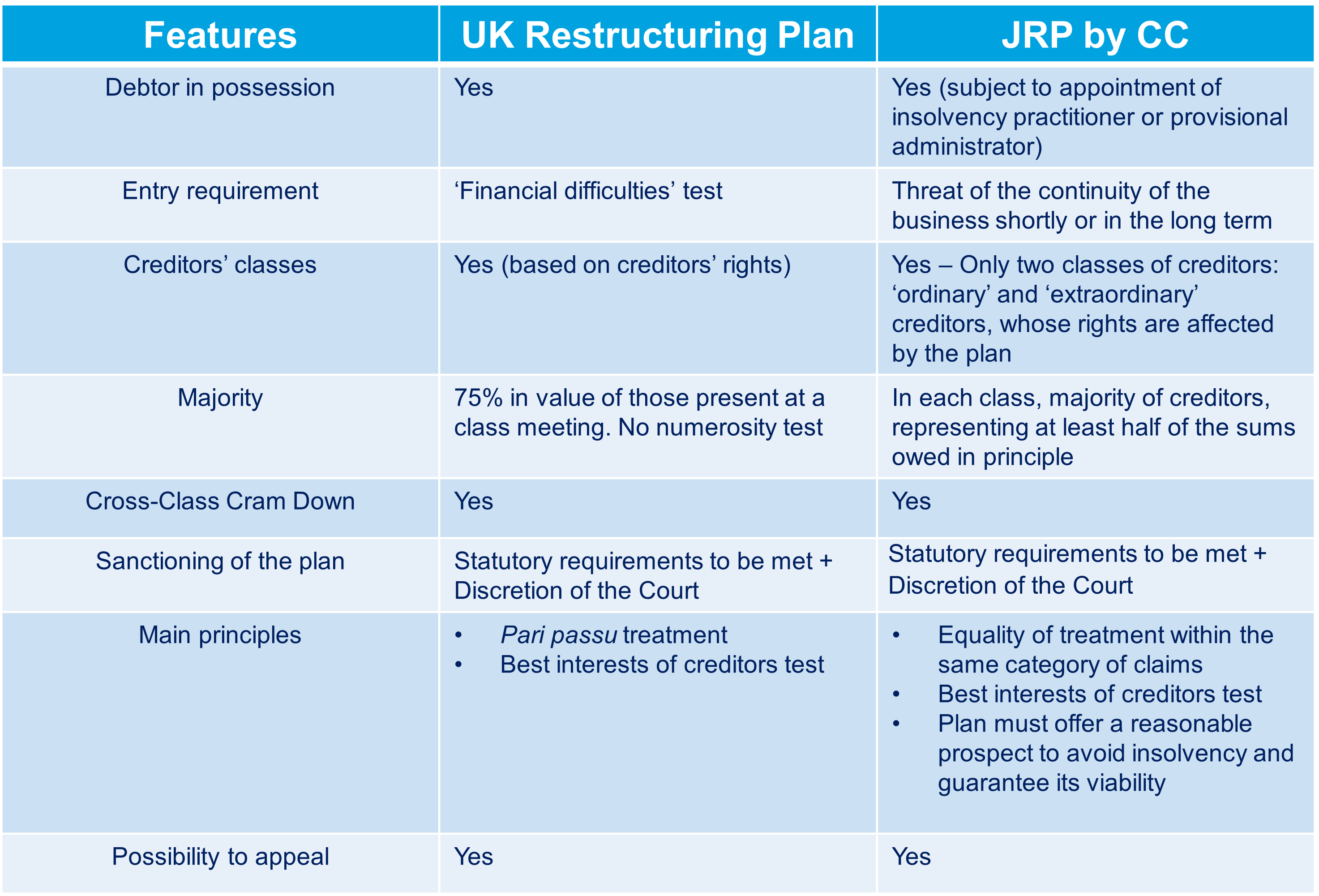The Law provides for three types of JRP, depending on the objective of the procedure (noting that the JRP can pursue a specific objective for each activity or activity portion):
- The obtention of a stay to conclude an amicable agreement (accord amiable).
- The obtention of creditors’ consent on a reorganisation plan to reach a collective agreement (accord collectif).
- The transfer, by a court decision, of all or part of the debtor’s assets or activities.
Focusing on the second possible objective of a JRP, the judicial reorganisation by collective consent (réorganisation judiciaire par accord collectif) (the JRP by CC) is one of the most significant changes to the Luxembourg insolvency and restructuring landscape introduced by the Law and has the potential to influence the way and jurisdiction many restructurings are implemented.
What is it?
The JRP by CC is a promising and flexible new judicial reorganisation proceedings aiming at preserving the continuity of all or part of the assets or the business of a debtor under the supervision of the court. In particular, the JRP by CC:
- is, in principle, a ‘debtor in possession’ process, subject to the designation of (i) an insolvency practitioner (mandataire de justice) to assist the debtor (at the request of the debtor or an interested third-party) or (ii) a provisional administrator (administrateur provisoire) (at the request of any interested party or public prosecutor) in case of serious faults (fautes graves et caractérisées);
- is subject to creditors’ approval;
- provides for a cross-class cram-down mechanism permitting such a plan to be imposed on a dissenting class of creditors; and
- is subject to court oversight and sanction.
When can a JRP by CC be proposed?
When the continuity of the business is threatened shortly or in the long term.
The state of bankruptcy of the debtor does not prevent the opening or the continuation of a JRP.
Who proposes the JRP by CC?
The debtor files a request to open a JRP.
What is the applicable procedure?
- Filing of the request (by the debtor), together with supporting documents (the Filing)
- Information of the public prosecutor by the court clerk (within 48 hours of the Filing)
- Designation of a delegate judge (juge délégué)
- Opening of a file of the judicial reorganisation (dossier de la réorganisation judiciaire)
- Examination of the request by the court (within 15 days of the Filing)
- Audition of the debtor (unless waived)
- Audition of the delegate judge (report)
- Judgement approving or rejecting the request to open the JRP (within 8 days of the examination of the request) (the Initial Judgement)
- Notification of the Initial Judgement to the debtor and publication of the Initial Judgement opening the JRP in the Recueil électronique des Sociétés et Associations (RESA)
- Communication of the Initial Judgement opening the JRP by CC by the debtor to the creditors (within 14 days of the Initial Judgement)
- Optional designation of an insolvency practitioner (mandataire de justice) or a provisional administrator (administrateur provisoire)
- Possible appeal of the Initial Judgement (within 8 days of the notification of the Initial Judgement)
What are the main effects?
- Subject to certain exceptions, no bankruptcy, judicial liquidation or enforcement measures can be declared or taken (as from the Filing)
- Suspension of the obligation to file for bankruptcy (as from the Filing) Stay on payments (for an initial maximum period of up to 4 months, with possible extensions up to a total maximum of 12 months)
- Subject to certain exceptions and to applicable contractual provisions, continuation of contracts
- Possible suspension of execution of certain agreements when reorganization imperatively so requires
What can be agreed as part of the Plan?
A plan under a JRP by CC (the Plan) may take many forms aiming at remedying the company’s financial difficulties, notably:
- Amendments and/or extensions of existing financial agreements, e.g. payment terms and reductions in principal and interest surpluses debt; differentiated settlement of certain categories of debts, in particular according to their size or nature; waiver of interests or rescheduling of such interest payment; set-off of amounts realized against the principal amount of the debt as a priority
- Debt for equity swaps
Where certain categories of claims are treated differently, the relevant creditors must be treated equally within these categories and in proportion to the amount of their claim.
The Plan must meet the criterion of the best interests of the creditors in that no creditor is in a less favorable situation as a result of the Plan than it would be if the normal order of priorities were applied, either in the case of bankruptcy or judicial liquidation, or in the case of a better alternative solution, if the Plan were not approved.
The deadline for the application of the Plan cannot exceed 5 years as from its sanctioning.
Sanctioning of the Plan
After the vote of each class of creditors on whether to accept the proposed Plan, final approval rests with the court.
The court can decide not to sanction the Plan only in limited circumstances, in particular:
- failure to comply with formalities provided for in the Law;
- the new funding is not necessary to implement the Plan and/or has an excessive adverse impact on the creditors’ interests;
- the Plan does not offer a reasonable prospect of avoiding the debtor's insolvency and ensuring its viability; or
- violation of public order.
Upon the debtor’s proposal or with the debtor’s approval, the court can also decide to sanction a Plan even where there is a dissenting class of creditors or members that voted against the Plan, subject to certain conditions and in particular:
- the new funding is necessary to implement the Plan and does not have an excessive adverse impact on the creditors’ interests;
- if the Plan has been approved by the class of ‘ordinary’ creditors only, ‘extraordinary’ creditors are treated more favorably than ‘ordinary’ creditors; and
- no class of creditors (affected parties) receives or keeps more than the total of its claims or interests, as part of the Plan.
The sanctioning of the Plan makes it binding to the creditors taking part in the procedure.
Subject to disputes arising from the execution of the Plan, the judgement relating to the sanctioning of the Plan (the Plan Judgement) closes the judicial reorganization procedure. The Plan Judgment is published in the RESA and notified to the debtor and the creditors. The Plan Judgement is subject to appeal within 15 days of its notification.
Looking to the future
The JRP by CC is expected to be an attractive tool for companies undertaking large restructurings as it can offer groups the opportunity to deliver a financial and operational restructuring using one single process. Thanks to the cross-class cram-down feature it offers, it will give companies more leverage over dissenting creditors and more comfort to companies which do not have approval from all classes at the point of proposing a Plan. The cross-class cram-down mechanism will also be useful in order to handle creditors whose claims cannot (for any reason) be released contractually.
The low voting threshold is also an appealing feature of the JRP by CC and will appear particularly useful in restructurings where the level of support from creditors cannot be predicted with certainty.
The JRP by CC seems to be a credible alternative to commonly used legal processes involving the reorganization of a debtor’s debts and assets, such as procedures under Chapter 11 of the US Bankruptcy Code or UK Restructuring Plans, which have proved to be very powerful tools for restructuring of distressed groups. It will however need to be tested in practice and it will be interesting to see how, and how fast, the JRP by CC will be put into practice.
We will cover further aspects of the Law and the tools it provides for in future issues of our series.







